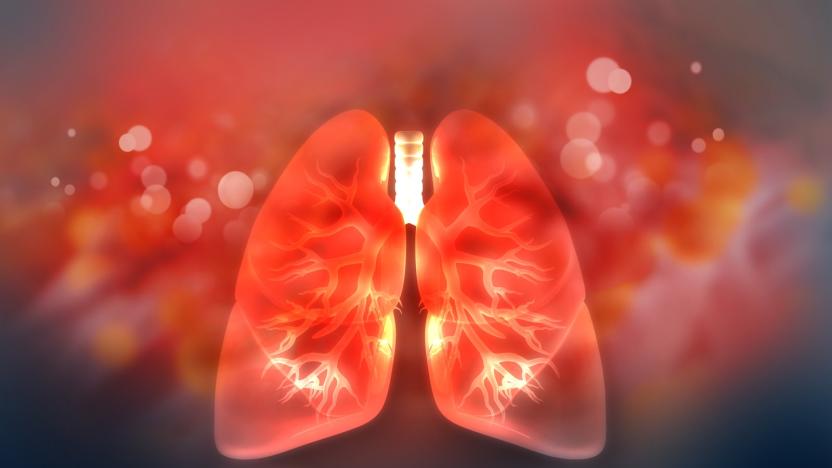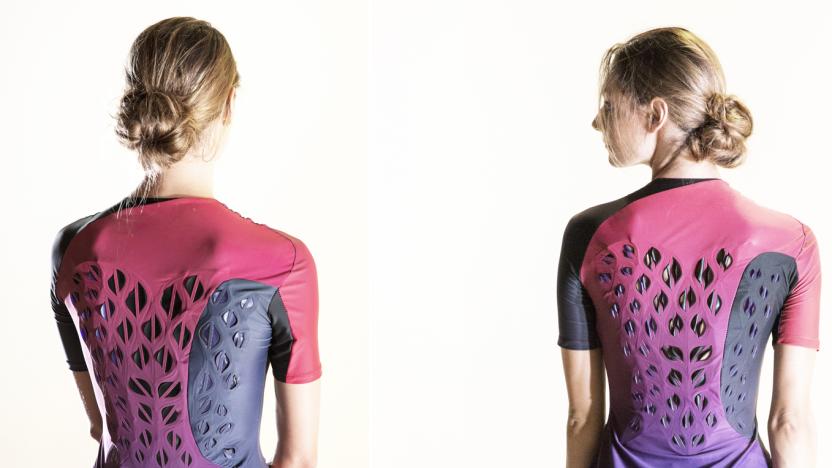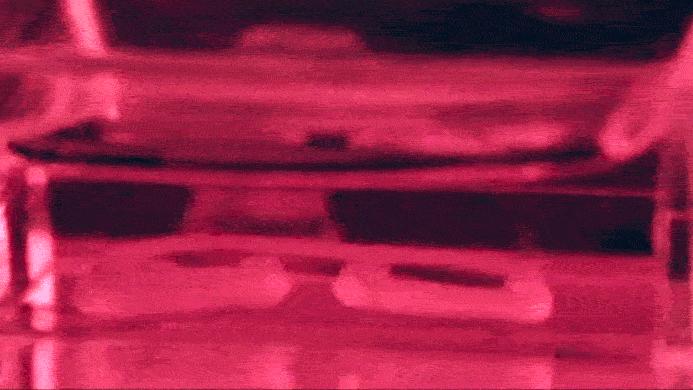bioengineering
Latest

Researchers create lung 'blueprint' that could aid organ regeneration
Serious lung disease has a high rate of mortality, and the only curative treatment is a lung transplant. This is a complicated procedure that has other adverse health effects and oftentimes simply doesn't work, so for scientists in this field, organ regeneration -- that is, growing an organ from the body's own tissue -- is the ultimate solution. Now, researchers from Yale say they're on track for this very eventuality.

Scientists successfully transplant lab-grown lungs into pigs
Lab-grown organ transplants aren't right around the corner, but they may considerably closer than you think. University of Texas Medical Branch researchers have successfully tested bioengineered lungs in adult pigs, with no signs of medical complications. While it's not certain how effective the lungs were at oxygenating the pigs, they developed the sturdy network of blood vessels needed to survive. The challenge, as you might guess, was producing a full structure that the pigs' bodies would accept.

AI offers a new way to look inside living human cells
Over the course of their careers, biologists develop a huge mental library of cell structures and their corresponding data. Investigating specific areas of a living cell involves a piecemeal approach, identifying how some parts work with others and spending time on cell labelling. But now, the Allen Institute for Cell Science has launched the first predictive 3D model of a live human cell -- the Allen Integrated Cell -- and it could be "a total game changer", according to researchers.

Bacteria open vents in this shirt when you sweat
Fashion and tech are teaming up yet again. Engineers at MIT have designed a workout suit that responds to your body heat, according to a study published last week in Science Advances. The clothing, made from latex, is covered with thumbnail- to finger-sized ventilating flaps that open and close depending on how much heat your body puts out. But what's controlling the flaps isn't something you'll find weaved into your usual workout gear -- it's bacteria.

ICYMI: Wearable robots will walk all over you
try{document.getElementById("aol-cms-player-1").style.display="none";}catch(e){} Today on In Case You Missed It: MIT and Stanford researchers created tiny robots that can grab onto clothes and walk on your shirt, with the goal of them one day, forming a swarm to create a temporary video screen and then marching back into a pocket, putting themselves away. Meanwhile Japanese scientists were able to create mice offspring from skin cells of adult mice. They're testing the method next with primates, so this is going to get even weirder. In TL;DR, we're rounding up some of the biggest headlines from the week and we think it's particularly interesting to note how much money technology companies now spend on lobbying in Washington, D.C. (And share it with your friend who still thinks tech and politics aren't related.) Also if you need to send that smoking Samsung video to someone stat, the original video is here. As always, please share any interesting tech or science videos you find by using the #ICYMI hashtag on Twitter for @mskerryd.

Harvard researchers built a living robot out of rat hearts
What do you get when you mix the heart cells of a rat with silicone from breast implants and then sprinkle in a bit of gold and genetic engineering? No, not Trump's next trophy wife -- you actually get this incredible "living" robot. Developed by a team of researchers at Harvard University, the bio-engineered marvel looks, flexes and swims just like a tiny stingray.

Watch tissue-based robots move in response to light
Researchers have modified muscle cells to move in response to light, which could eventually result in "bio-bots" useful for health or environmental applications. The breakthrough was made possible by the rapidly expand field of optogenetics, in which algae genes are spliced with muscle tissue from mice to make it sensitive to blue light. The team from the University of Illinois started with a 3D-printed hydrogel skeleton, then looped a ring of the modified tissue around. By firing a flash intermittently, they were able to make the muscle move, and even "exercise" it to become stronger.

Instant man-made blood vessels could speed up drug discovery
Man-made tissues and organs are useful tools for scientists seeking to understand and potentially fix the human body. One area in which they could have a significant impact is drug discovery, allowing researchers to test therapies in living models prior to animal and human trials. A group of biomedical engineers at Duke University are particularly interested in this use case, leading them to develop a new technique for creating working blood vessels in the lab. And what previous methods took six to eight weeks to achieve, the researchers have managed to condense into a matter of hours.

Oxford University researchers create new 3D printed 'soft material' that could replace human tissue
Water and fat -- those are the two primary building blocks Oxford University researchers have used to 3D print the droplet you see above. Sounds unremarkable until you consider its intended application as a human tissue replacement. By stringing together thousands of these so-called droplets (which measure about 50 microns across) using a custom-built 3D printer, the Oxford team believes it has engineered a "new type of material" that could eventually be used to ferry drugs throughout our internal systems to a specific target site, fill-in for damaged tissues or even mimic neural pathways via specially printed protein pores. The potential applications for medical science are impressive enough, but consider this additional benefit: since the droplets contain no genetic material, scientists can completely sidestep all the ethical red tape surrounding the alternative stem cell approach to artificial tissue. At present, the team's been able to string about 35,000 of the droplets together, but there's no real cap as to how large or even what type of networks can be made. If the money and equipment are willing, this Oxford team can make scifi dreams come true.

Fake jellyfish made from rat cells have a place in our hearts (video)
There's a whole sea of jellyfish out there ready to sting indiscriminately. So, why do we keep trying to make them? Scientists from Harvard and Caltech have a pretty good reason for creating fake jellies -- they hope to mend broken hearts by adapting their 'pumping' style of movement. Much like our own vital organ, the creatures are a mass of muscle adept at shifting fluid, meaning the research has several medical applications, such as bioengineered pacemakers for busted tickers. In creating the Medusoids, the team used a silicon scaffold coated in functional rat cardiac tissue, copying the muscle layout of a real jellyfish as best they could. When immersed in salt water and treated to bursts of current, the cells contract and cause the silicon sheet to move in a way eerily similar to the real thing. Next step for the team? An autonomous version that can move and potentially feed without their influence, of course. And, after seeing the little swimmers in action, we've certainly got palpitations. See what we mean after the break.

Researchers use 3D printer, sugar, to create a fake artery network for lab-grown tissue
Printing a chocolate heart is easy enough, but how about an actual organ? There are folks working on it, but it turns out those veins of yours aren't exactly a breeze to replicate. Researchers at the University of Pennsylvania and MIT may have found a semi-sweet solution -- dissolving a sugar lattice in a batch of living Jell-O. The research team uses a RepRap 3D printer and a custom extruder head to print a filament network composed of sucrose, glucose and dextran which is later encased in a bio-gel containing living cells. Once the confectionery paths are dissolved, they leave a network of artery-like channels in their void. Tissue living in the gel can then receive oxygen and nutrients through the hollow pipes. The research has been promising so far, and has increased the number of functional liver cells the team has been able to maintain in artificial tissues. These results suggest the technique could have future research possibilities in developing lab-grown organs. MIT Professor Sangeeta Bhatia, who helped conduct the effort, hopes to push the group's work further. "More work will be needed to learn how to directly connect these types of vascular networks to natural blood vessels while at the same time investigating fundamental interactions between the liver cells and the patterned vasculature. It's an exciting future ahead." Scientists at other labs could also get their mitts on the sweet templates since they're stable enough to endure shipping. Head past the break for a video of the innard infrastructure.

Salmon sperm used to intensify LEDs, grossify everyone
See, the problem with bioengineering isn't moral or ethical dilemmas, or even homicidal robo-droids enslaving humanity. It's that if you let researchers go wild, eventually they'll find a way to make LEDs out of salmon sperm, threatening the sanctity (and sperm-free-ness) of your entire gadget-based lifestyle. Yet that's exactly what Professor Andrew Steckl of the University of Cincinnati has managed to do, using the DNA found in salmon sperm to enhance the brightness of LEDs. The so-called BioLEDs are being developed in cooperation with the Air Force (yes, the Air Force -- they had a "good source" of salmon sperm, apparently) and they've been so successful that Steckl has been getting salmon sperm from researchers worldwide "wanting to see if their sperm is good enough." Steckl says that since salmon sperm is considered a waste product of the fishing industry, BioLEDs are particularly green -- kind of like our faces right now.

Duda Farm develops "celery straws," crazy straws bend their necks in shame
Hate to be the one that has to tell you this, but swilling your drinks with those lame ass plastic straws is officially passe. From now on it's celery straws or nothing for us, thanks to Florida's Duda Farm Fresh Foods and their l33t bioengineering skilz. Those farming crazies have managed to design stalks of celery that grow in a tube form, allowing for edible straws in your Bloody Mary or a peanut butter surprise inside this tubular wonder. Is there no limit to human ingenuity?[Via Boing Boing]









